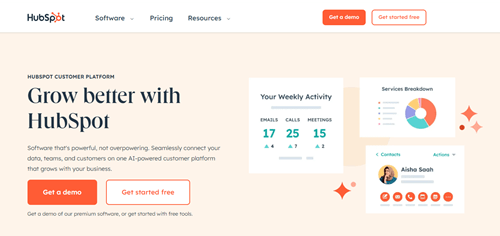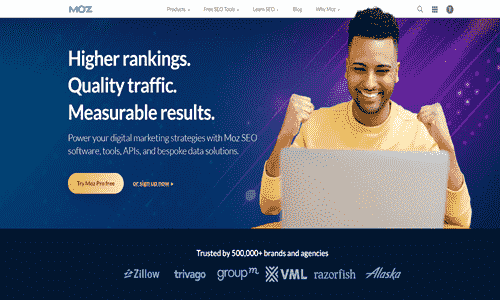
Mastering SaaS SEO: Unlocking Organic Growth for Business
In the dynamic landscape of Software as a Service (SaaS), mastering SEO (Search Engine Optimization) is paramount for driving visibility, attracting qualified leads, and ultimately, achieving business success. SaaS SEO involves optimizing your digital presence to ensure your software solutions rank prominently in search engine results, capturing the attention of potential customers actively seeking your services. By implementing strategic SEO tactics tailored to the unique needs of the SaaS industry, you can enhance your online visibility, outshine competitors, and propel your SaaS business to new heights of growth and profitability.
What is SaaS SEO?
SaaS SEO refers to search engine optimization (SEO) strategies specifically tailored for Software as a Service (SaaS) businesses. This involves optimizing various aspects of a SaaS company’s online presence to improve its visibility and ranking in search engine results pages (SERPs), ultimately driving organic traffic to its website.SaaS SEO involves techniques such as keyword research, on-page optimization (like optimizing website content, meta tags, and URLs), off-page optimization (such as link building and social media engagement), and technical SEO (ensuring website structure, performance, and indexing are optimal). The goal is to increase the likelihood of potential customers discovering SaaS companies through search engines when looking for SaaS product solutions.
Why should SaaS companies focus on SEO?
SaaS companies should prioritize SEO for several compelling reasons:
Increased Visibility:
SaaS enterprises can increase their exposure in search engine results pages (SERPs) by using SEO to help prospective customers find their products or services.
SaaS organizations may increase their organic traffic from people actively searching for answers to their problems by ranking better for relevant keywords and phrases.
Cost-Effective Lead Generation:
Organic traffic generated through SEO is a sustainable and cost-effective lead-generation strategy compared to paid advertising.
While paid advertising can provide immediate results, it requires ongoing investment and may become prohibitively expensive. In contrast, the benefits of SEO can compound over time, resulting in long-term organic traffic and lead generation at a lower cost.
Brand Credibility:
A robust online presence and good search engine rankings bolster a SaaS company’s brand credibility and authority within the sector.
Companies that perform well in search engine rankings are usually viewed by users as more trustworthy, which increases brand recognition and customer confidence.
Customer Acquisition:
SaaS enterprises can connect with prospective clients at different phases of the buyer’s journey through efficient SEO.
SaaS organizations may drive client acquisition and conversions by optimizing content for various search intents, ranging from transactional terms to informational queries. This allows them to attract consumers at the awareness, contemplation, and decision-making stages.
Types of SaaS SEO SaaS
SEO encompasses various strategies and tactics, including:
Technical SEO:
Technical SEO aims to enhance a website’s overall performance, indexability, and crawlability for search engines by optimizing its technical elements. This covers enhancing mobile friendliness, streamlining the website’s pace, repairing broken links, and putting structured data markup for rich snippets into practice.
Additional technical SEO tactics include optimizing robots.txt files, XML sitemaps, and canonical tags and addressing duplicate content, URL structure, and site architectural concerns.
On-Page SEO:
Optimizing individual web pages for search engines to increase relevancy, visibility, and ranking on search engine results pages (SERPs) is known as on-page SEO. This entails optimizing headers (H1, H2, H3), image alt attributes, and meta tags (title tags, meta descriptions) for pertinent keywords and search intent.
Other on-page optimization techniques include optimizing URL structures, improving internal linking, optimizing content formatting and readability, and incorporating semantic markup (schema.org) to provide context to search engines.
Content Marketing:
Content marketing is essential to SaaS SEO, as it produces useful, educational, and captivating material that attracts potential customers. This includes producing blog posts, guides, whitepapers, case studies, films, podcasts, and other types of content to meet the demands and pain areas of the target audience.
Effective content marketing involves conducting keyword research to identify relevant topics and search queries, creating high-quality content that provides solutions and answers to user queries, and promoting content through various channels to reach and engage with the target audience.
Link Building:
Link building is obtaining high-quality backlinks from reliable websites to raise a SaaS company’s search engine rankings and domain authority. Outreach, establishing connections, and promoting content are all necessary to draw in natural backlinks from reputable and pertinent sources.
Link-building strategies include guest blogging, contributorship, digital PR, content partnerships, and participating in industry forums and communities to earn backlinks and enhance online visibility.
Local SEO:
Local SEO optimizes a SaaS company’s online presence for local search queries. This is particularly relevant for companies with physical offices or targeting specific geographic regions.
This includes optimizing Google My Business profiles, creating local citations, and obtaining positive reviews and ratings from satisfied customers.
Some other local SEO tactics include optimizing location pages, incorporating local keywords into meta tags and content, and getting involved in community activities and sponsorships to establish local authority and trust.
Best Practices for SaaS SEO
To maximize the effectiveness of SaaS SEO efforts, companies should adhere to the following best practices:
Keyword Research:
Start by brainstorming potential keywords and phrases your target audience might use when searching for SaaS solutions.
Use keyword research tools like Google Keyword Planner, SEMrush, or Ahrefs to find appropriate terms, gauge search traffic, and examine keyword competitiveness.
Prioritize long-tail keywords and phrases that are more specific and have lower competition, as they often yield higher-quality traffic and better conversion rates.
User Experience Optimization:
To optimize your website’s speed, reduce page load times, reduce picture size, and use browser caching.
Ensure your design is responsive for a smooth user experience across PCs, tablets, and smartphones.
Simplify menu structures, provide users with obvious paths to traverse the site, and arrange material logically to improve site navigation.
Employ clear calls to action (CTAs) to direct customers toward desired behaviors, such as requesting a demo, signing up for a free trial, or subscribing to a newsletter.
Content Strategy:
Develop a content strategy that considers your target audience’s needs, interests, and problems at each stage of the purchasing process.
Produce informative, high-quality content that answers frequently asked issues, offers insightful commentary, and showcases your proficiency with the SaaS sector.
Provide a variety of content formats, such as blog articles, case studies, whitepapers, films, webinars, and infographics, to accommodate varying tastes and consumption patterns.
To maintain valuable and relevant content, optimize it for relevant keywords, add internal linking to enhance navigation and SEO, and update and renew it frequently.
Technical SEO Audits:
Conduct regular technical SEO audits to identify and address issues that may impact your website’s indexability, crawlability, and search engine ranking.
Examine your work for technical problems, including broken links, repetitive material, improperly formatted schema markup, and missing meta tags.
To aid with search engine crawling and indexing, ensure your website has the right hierarchy and structure, optimize your URL structures, and produce XML sitemaps.
Check for responsiveness and usability on mobile devices across various screen sizes and address potential usability problems.
Link Building and Digital PR:
Create a well-thought-out link-building plan to obtain high-quality backlinks from reliable SaaS sector websites and authoritative sources.
Find appropriate venues for guest posting, contributing, and working with periodicals, opinion leaders, and industry influencers.
In addition to actively promoting material through social media, email outreach, and networking channels, create valuable, shareable content that naturally draws backlinks and social shares.
You are maintaining a broad and natural link profile that reflects the authority and credibility of your SaaS brand. Regularly monitor and evaluate backlink profiles, disavow low-quality or spammy backlinks, and work to retain these attributes.
Case Studies: Successful SaaS Companies and their SEO Strategies
HubSpot:

SEO Strategy:
A comprehensive content marketing and SEO strategy has been the cornerstone of HubSpot’s success as a top inbound marketing and sales platform. They constantly provide educational, high-quality content suited to various phases of the buyer’s journey.
Approach:
HubSpot invests heavily in keyword research to find pertinent subjects and tailor content to search engines. They use long-tail keywords to draw in organic visitors, respond to frequently asked queries, and offer insightful information.
Results:
HubSpot’s SEO efforts have contributed to significant organic traffic growth. Their blog serves as a primary source of leads and conversions. They rank well for competitive marketing and sales software keywords, driving brand awareness and customer acquisition.
Slack:

SEO Strategy:
Popular team collaboration and communication tools Slack prioritizes technical SEO, content strategy, and website structure optimization to increase search exposure and draw in organic visitors.
Approach:
Slack ensures a seamless user experience with fast-loading pages, mobile responsiveness, and clear navigation. They create informative resources such as guides, tutorials, and case studies to address user needs and provide value.
Results:
Slack ranks prominently for relevant keywords related to team communication, productivity, and remote work. Their well-optimized website and content strategy contribute to consistent organic traffic growth and brand recognition in the competitive SaaS market.
Moz:

SEO Strategy:
Moz, one of the top SEO tools and software suppliers, implements advanced SEO tactics to increase its online presence and draw in targeted traffic.
Approach:
Moz prioritizes technical SEO, regularly auditing its website for issues and implementing best practices for crawlability, indexability, and site speed. It also produces comprehensive, data-driven content, including industry reports, whitepapers, and how-to guides, to establish thought leadership and attract backlinks.
Results:
Moz’s SEO efforts have helped it maintain a dominant presence in the SEO software space. It ranks highly for competitive keywords and attracts a large, engaged audience. Its authoritative content and strong backlink profile contribute to sustained organic traffic and lead generation.
Future Trends in SaaS SEO
SaaS organizations need to keep up with the latest developments in SEO since the digital landscape keeps changing. These trends include:
Voice Search Optimization:
As virtual assistants like Siri, Alexa, and Google Assistant become more integrated into daily life, optimizing for voice search will be essential. SaaS companies should focus on natural language queries and conversational keywords to align with how users interact with voice-activated devices.
Additionally, optimizing for local voice search queries will be crucial for SaaS companies targeting specific geographic regions, as users increasingly use voice search to find nearby businesses and services.
Artificial Intelligence and Machine Learning:
AI and ML algorithms are shaping the future of search engine algorithms, enabling a more sophisticated understanding of user intent and context. SaaS companies must adapt their SEO strategies to focus on semantic search and context-based optimization.
AI-driven content personalization will also become more prevalent, with search engines delivering customized search results based on user preferences, behavior, and demographics.
Mobile-First Indexing:
With the dominance of mobile devices in online browsing, search engines prioritize mobile-first indexing to ensure a seamless user experience for mobile users. SaaS companies must optimize their websites for mobile devices, including responsive design, fast loading times, and intuitive navigation.
Additionally, leveraging features like Accelerated Mobile Pages (AMP) and Progressive Web Apps (PWAs) can enhance mobile performance and user engagement, improving search rankings and visibility.
Visual Search Optimization:
Visual search is gaining traction as users increasingly rely on images rather than text to find information and products online. SaaS companies should optimize images with descriptive alt text, structured data markup, and high-quality visuals to improve visibility in visual search results.
Adding visual search functionality to their platforms can also improve user experience and increase engagement, especially for SaaS solutions with visual components, such as project management software or design tools.
E-A-T and Brand Authority:
Expertise, Authoritativeness, and Trustworthiness (E-A-T) are becoming critical ranking factors as search engines prioritize content from authoritative sources. SaaS companies should build brand authority through thought leadership, industry partnerships, and transparent, credible content.
Investing in online reputation management, customer reviews, and social proof can also bolster E-A-T signals and improve search rankings and trustworthiness in the eyes of both search engines and users.
Common Mistakes to Avoid in SaaS SEO
To ensure the success of SaaS SEO efforts, companies should avoid common pitfalls such as:
Keyword Stuffing:
Keyword stuffing involves excessively using keywords to manipulate search engine rankings. This violates search engine guidelines and results in a poor user experience. Instead, focus on using keywords naturally and strategically within your content to provide value to users and improve relevance.
Neglecting Technical SEO:
Despite being the cornerstone of any effective SEO plan, technical SEO is frequently disregarded. Ignoring technical problems can greatly influence search engine visibility and user experience. These problems include slow site speed, poor mobile responsiveness, and crawlability concerns. To guarantee optimum performance, routinely check your website for technical problems and take quick action to fix them.
Duplicate or Thin Content:
Duplicate content refers to identical or highly similar content across multiple pages or websites, while thin content refers to low-quality, shallow content that provides little value to users. Both can harm search rankings and user engagement. Focus on creating original, high-quality content that addresses user needs, provides valuable insights, and differentiates your brand from competitors.
Lack of Link Building:
Even though link development is essential to off-page SEO, many SaaS companies overlook this part of their marketing mix. Without top priority given to link-building initiatives, increasing domain authority, raising search engine ranks, and successfully competing in search results can be challenging. Invest in digital PR, guest blogging, content promotion, and other strategic link-building operations to gain high-quality backlinks from reputable sources.
Ignoring User Experience (UX):
Because search engines reward websites that offer a smooth and gratifying user experience, user experience is critical to SEO. Insufficient focus on user experience elements like call to action, responsive design, and easy navigation can lead to poor dwell times, high bounce rates, and worse search engine rankings. Improve your website’s usability and accessibility to boost search engine rankings and user experience.
Failing to Adapt to Algorithm Updates:
Because search engine algorithms are always changing, ignoring these alterations could harm SEO effectiveness. Staying up to date with algorithm modifications, industry advancements, and optimal techniques is vital for sustaining and enhancing your search engine results over time.
Measuring ROI and Success Metrics for SaaS SEO
To evaluate the effectiveness of SaaS SEO efforts and justify ongoing investments, companies should track and measure relevant metrics, such as:
Organic Traffic:
Monitoring the volume of organic traffic from search engines provides insights into the effectiveness of SaaS SEO efforts in driving website visitors. Analyze trends in organic traffic over time to identify growth opportunities and areas for improvement. Additionally, segment organic traffic by landing pages, keywords, and user demographics to understand which areas of the website are performing well and where optimization efforts are needed.
Keyword Rankings:
Monitoring the positioning of specific keywords on search engine results pages (SERPs) is essential for determining visibility and the likelihood of increasing organic traffic. Keep a close eye on keyword rankings to spot any patterns or swings that can affect organic traffic. For long-term keyword ranking maintenance or improvement, concentrate on content optimization and enhancing website authority.
Lead Quality and Conversion Rates:
Analyzing the quality of leads generated from organic search and their conversion rates into customers provides insights into the effectiveness of SaaS SEO in driving business outcomes. Evaluate lead quality metrics such as lead source, engagement level, and conversion propensity to assess the impact of organic traffic on the sales pipeline. Additionally, track conversion rates at each funnel stage to identify optimization opportunities and improve overall conversion performance.
Return on Investment (ROI):
Calculating the ROI of SaaS SEO efforts is essential for justifying ongoing investments and optimizing resource allocation. Compare the costs of SEO implementation, including personnel, tools, and external services, to the revenue generated from organic search traffic. Consider direct revenue, such as sales attributed to organic traffic, and indirect benefits, such as brand visibility and customer lifetime value. Aim for a positive ROI to ensure that SaaS SEO contributes to business growth and profitability.
User Engagement and Behavior:
Examine metrics related to user engagement, like bounce rate, average session length, and pages per session, to evaluate the standard of organic traffic and user experience. Monitor conversion paths and behavior flow to spot potential problems and improve your website’s usability and navigation. Furthermore, monitor click-through rates (CTRs) for organic search results to assess how well meta descriptions and title tags encourage clicks from search engine users.
Frequently Asked Questions
How long does it take to see results from SaaS SEO?
The industry’s level of competition, the website’s age and authority, and the volume of SEO work done can all affect how long it takes to see benefits from SaaS SEO. In general, noticeable gains in search ranks and organic traffic may take several months to a year.
Can SaaS SEO replace paid advertising?
SaaS SEO is not a perfect substitute for paid advertising, even though it might be a reasonably priced lead-generation tactic. A well-rounded marketing strategy should incorporate paid and organic channels for maximum efficacy and reach.
Is SaaS SEO different from traditional SEO?
SaaS SEO necessitates particular techniques and tactics due to the distinctive nature of software goods and services, even if the fundamentals of SEO apply to all industries. This entails tackling intricate sales cycles, optimizing for particular buyer personas, and producing content covering several phases of the buyer’s journey.
How important is content marketing for SaaS SEO?
Content marketing is a critical component of SaaS SEO. By creating high-quality, informative, and engaging content, SaaS companies can attract and retain potential customers, establish thought leadership, and improve search engine visibility for relevant keywords and topics.
Should SaaS companies focus on local SEO?
While many SaaS companies operate globally, local SEO can still be valuable for targeting specific regions or industries. Optimizing local search queries can help SaaS companies reach potential customers in specific geographic areas or verticals.
How can SaaS companies measure the ROI of their SEO efforts?
To measure the ROI of SaaS SEO efforts, companies should track organic traffic, keyword rankings, lead quality, conversion rates, and revenue generated from organic search. By comparing these metrics to the costs of implementing SEO strategies, SaaS companies can calculate the return on their SEO investments.
Conclusion
In conclusion, SaaS SEO is essential to any software or service business’s digital marketing strategy. By implementing effective SEO techniques tailored to the unique needs of SaaS companies, such as thorough keyword research, on-page optimization, off-page strategies, and technical SEO enhancements, businesses can significantly improve their online visibility and attract more qualified website traffic. A well-executed SaaS SEO strategy can ultimately increase brand awareness and higher conversion rates and sustain business growth in a competitive online landscape.




